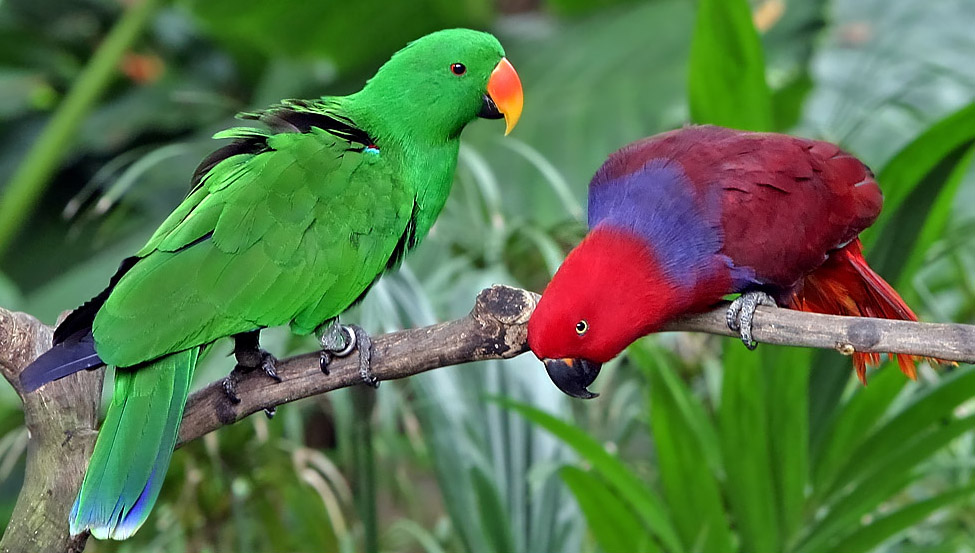
29 July 2025
The name "Eclectus" itself, derived from "eclectic," refers to the disparate colors of the male and female. This dramatic difference, known as sexual dimorphism, is immediately noticeable. Males are predominantly a shining emerald green with red underwing coverts and sides, and an orange-yellow upper mandible. Females are typically blue and maroon with both mandibles black. This contrast was so significant that, until the early 20th century, they were considered different species. Eclectus also possess a feathered cere, and their hair-like feathers, particularly on the female's breast and abdomen, give a fur-like appearance. Unlike many birds, they do not undergo a hard moult, instead dropping a few feathers about three times a year.
Temperamentally, Eclectus parrots are often misunderstood. While they may appear shy or lethargic when stressed or in unfamiliar situations, in familiar surroundings with known people, they are garrulous, highly animated, curious, affectionate, and playful. They boast a wide range of pleasant sounds, including bell tones, coos, and whistles, and can mimic words and phrases very clearly, especially when hand-reared.
The Eclectus parrot's natural range spans New Guinea, Australia, the Solomon Islands, and the Indonesian Archipelago, leading to significant variation in size and, to a lesser extent, color. The nominate race is the Grand Eclectus (Eclectus roratus roratus), and there are nine known subspecies. The Red-sided Eclectus (Eclectus roratus polychloros) is the most common subspecies found in Australian aviaries, with its female lacking yellow in her plumage and having a royal blue abdomen contrasting with crimson, and the male being bright forest green with a pale yellow tail tip. The Solomon Island Eclectus (Eclectus roratus solomonensis*) is notably smaller and more compact. Some rarer subspecies, like E.r. cornelia and E.r. riedeli, are very difficult to acclimate to aviculture due to poor condition upon trapping.
Eclectus parrots have unique nutritional requirements that set them apart from many other parrot species. In the wild, their diet consists primarily of fruits, nuts, berries, leaf buds, blossoms, nectar, leaf shoots, and insects, with seed playing only a minor role. This natural diet is high in vitamin and water content. In captivity, it's crucial to provide a diet rich in fresh fruits and vegetables, fortified with protein (e.g., cooked chicken legs, fish, hard-boiled eggs). They have a particularly high vitamin A requirement, which can be met by offering dark green or orange vegetables and fruits like carrots, broccoli, capsicum, and mango. Malnutrition, especially vitamin deficiency, is the most common cause of health problems and breeding failure in captive Eclectus. Quality and cleanliness of food and water are paramount.
Appropriate aviary design is essential for stress reduction and overall health. Eclectus parrots rarely come to the ground in their natural habitat, preferring food and water to be elevated at least 4-5 feet off the ground in aviaries. Non-porous floors, such as concrete, are recommended for hygiene to prevent bacterial, fungal, and parasitic infections like roundworms and hairworms. For their psychological security, aviaries should offer ample space and a safe haven or enclosed area where the birds can retreat from strangers or perceived predators. Nest boxes should be placed privately, with their entrance facing away from traffic. Suspended cages are also a suitable housing option, typically hung 3-4 feet off the ground, which also provides security.
Eclectus parrots are a matriarchal-dominated species, with the hen typically being more aggressive, especially when protecting the nest, while the cock is more docile. They are prolific breeders, often breeding continuously in aviaries. Compatibility between pairs is crucial for breeding success, as incompatibility is a major cause of infertility and stress. Housing young birds together can help foster compatibility. While typically housed as single pairs, colony breeding is possible and may even improve success, possibly due to their social structure in the wild where multiple pairs share nesting sites and exhibit "alloparenting" (communal feeding of young). In the wild, hens incubate eggs for the entire 28 days and rarely leave the nest, being fed by the cock. Chicks hatch nearly naked, but their down color can indicate sex (female: jet black, male: charcoal grey), and their sex can be confirmed by the first colored feathers at about four weeks. Males typically take over most of the feeding duties once the young fledge.